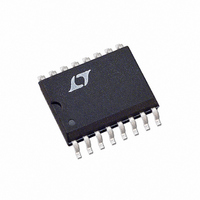LT1376CS Linear Technology, LT1376CS Datasheet - Page 17

LT1376CS
Manufacturer Part Number
LT1376CS
Description
IC SW REG 1.5A ADJ STP-DWN16SOIC
Manufacturer
Linear Technology
Type
Step-Down (Buck)r
Datasheet
1.LT1376CS8PBF.pdf
(28 pages)
Specifications of LT1376CS
Internal Switch(s)
Yes
Synchronous Rectifier
No
Number Of Outputs
1
Voltage - Output
2.42 ~ 21.5 V
Current - Output
1.5A
Frequency - Switching
500kHz
Voltage - Input
5 ~ 25 V
Operating Temperature
0°C ~ 125°C
Mounting Type
Surface Mount
Package / Case
16-SOIC (3.9mm Width)
Lead Free Status / RoHS Status
Contains lead / RoHS non-compliant
Power - Output
-
Available stocks
Company
Part Number
Manufacturer
Quantity
Price
Part Number:
LT1376CS
Manufacturer:
LINEAR/凌特
Quantity:
20 000
Company:
Part Number:
LT1376CS-5
Manufacturer:
AGERE
Quantity:
1 314
Part Number:
LT1376CS8
Manufacturer:
LINEAR/凌特
Quantity:
20 000
Part Number:
LT1376CS8#PBF
Manufacturer:
LINEAR/凌特
Quantity:
20 000
Company:
Part Number:
LT1376CS8#TR
Manufacturer:
LINEAR
Quantity:
7 388
Company:
Part Number:
LT1376CS8#TRPBF
Manufacturer:
LINEAR
Quantity:
10 119
Part Number:
LT1376CS8#TRPBF
Manufacturer:
LINEAR/凌特
Quantity:
20 000
Part Number:
LT1376CS8-5
Manufacturer:
LINEAR/凌特
Quantity:
20 000
Company:
Part Number:
LT1376CS8-5#TR
Manufacturer:
LT
Quantity:
41
APPLICATIONS
PARASITIC RESONANCE
Resonance or “ringing” may sometimes be seen on the
switch node (see Figure 7). Very high frequency ringing
following switch rise time is caused by switch/diode/input
capacitor lead inductance and diode capacitance. Schot-
tky diodes have very high “Q” junction capacitance that
can ring for many cycles when excited at high frequency.
If total lead length for the input capacitor, diode and switch
path is 1 inch, the inductance will be approximately 25nH.
Schottky diode capacitance of 100pF will create a reso-
nance at 100MHz. This ringing is not harmful to the
LT1376 and can normally be ignored.
Overshoot or ringing following switch fall time is created
by switch capacitance rather than diode capacitance. This
ringing per se is not harmful, but the overshoot can cause
problems if the amplitude becomes too high. The negative
voltage can forward bias parasitic junctions on the IC chip
and cause erratic switching. The LT1376 has special
circuitry inside which mitigates this problem, but negative
100mA/DIV
5V/DIV
5V/DIV
Figure 8. Discontinuous Mode Ringing
Figure 7. Switch Node Resonance
U
0.5µs/DIV
20ns/DIV
20ns/DIV
INFORMATION
U
W
1375/76 F08
1375/76 F07
1375/76 F11
RISE AND FALL
WAVEFORMS ARE
SUPERIMPOSED
(PULSE WIDTH IS
NOT 120ns)
SWITCH NODE
VOLTAGE
INDUCTOR
CURRENT
U
voltages over 1V lasting longer than 10ns should be
avoided. Note that 100MHz oscilloscopes are barely fast
enough to see the details of the falling edge overshoot in
Figure 7.
A second, much lower frequency ringing is seen during
switch off time if load current is low enough to allow the
inductor current to fall to zero during part of the switch off
time (see Figure 8). Switch and diode capacitance reso-
nate with the inductor to form damped ringing at 1MHz to
10 MHz. Again, this ringing is not harmful to the regulator
and it has not been shown to contribute significantly to
EMI. Any attempt to damp it with a resistive snubber will
degrade efficiency.
INPUT BYPASSING AND VOLTAGE RANGE
Input Bypass Capacitor
Step-down converters draw current from the input supply
in pulses. The average height of these pulses is equal to
load current, and the duty cycle is equal to V
and fall time of the current is very fast. A local bypass
capacitor across the input supply is necessary to ensure
proper operation of the regulator and minimize the ripple
current fed back into the input supply. The capacitor also
forces switching current to flow in a tight local loop,
minimizing EMI .
Do not cheat on the ripple current rating of the Input
bypass capacitor, but also don’t get hung up on the value
in microfarads . The input capacitor is intended to absorb
all the switching current ripple, which can have an RMS
value as high as one half of load current. Ripple current
ratings on the capacitor must be observed to ensure
reliable operation. The actual value of the capacitor in
microfarads is not particularly important because at
500kHz, any value above 5µF is essentially resistive. RMS
ripple current rating is the critical parameter. Actual RMS
current can be calculated from:
The term inside the radical has a maximum value of 0.5
when input voltage is twice output, and stays near 0.5 for
a relatively wide range of input voltages. It is common
I
RIPPLE RMS
( )
=
I
OUT
V
OUT
(
V
IN
LT1375/LT1376
−
V
OUT
)
/
V
IN
OUT
2
/ V
17
IN
. Rise
13756fd














